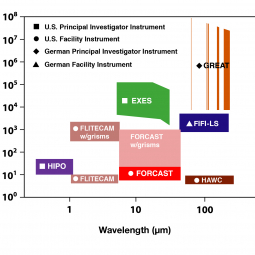SOFIA's instruments cover a wide range of wavelengths, from the near-ultraviolet to the far-infrared, as well as a wide range of spectral resolutions, from the broadband filters in the three infrared cameras to the very high resolution of the GREAT (German Receiver for Astronomy at Terahertz Frequencies) far-infrared heterodyne spectrometer. Capability "footprints" of SOFIA's planned suite of seven first-generation science instruments are shown in the graphic above.
Rolf Güsten of the Max-Planck-Institut für Radioastronomie in Bonn, Germany, leads the team that developed GREAT. Its newly commissioned, high-frequency "H" channel, operating at a frequency of 4.74 Terahertz (wavelength of 63 microns) was brought on-line during a series of flights in May 2014. From left to right (short to long wavelength) in the GREAT sector are columns delineating the wavelength and resolution coverages respectively of the H, Mb, Ma, L2, and L1 channels.
Use of a Facility Instrument can be proposed by any astronomer without restriction. Use of a Principal Investigator (P.I.) instrument requires collaboration with that instrument's P.I.
